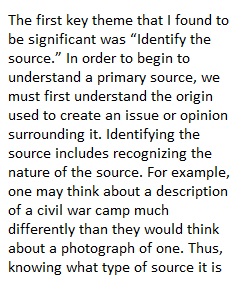


Q Initial Post: 1. For Part 1, read the article Reading Primary Sources and choose 3 key themes from the document that you find most interesting. Spend one paragraph discussing each theme (for a total of 3 paragraphs). In each paragraph, you should clearly identify the theme you have chosen in the first sentence, spend several sentences explaining the theme and providing examples from the article to illustrate your theme, and conclude with 1-2 sentences discussing why you think that particular theme is significant for understanding history. Each paragraph should thus be at least 6-7 sentences in length. 2. For Part 2, you will become a historian by applying what you have learned. For this part, you will analyze one of the primary sources you should have already read from unit 1 and from the textbook. Your answer in Part 2 should clearly reflect what you learned about analyzing sources in Part 1. Full points will not be awarded for answers that merely identify or summarize the primary source. Rather, they should (as the article notes), "identify it, contextualize it, explore it, analyze it, and evaluate it."
Q • Students whose last names begin with A-H will analyze “The Aztecs Predict the Coming of the Spanish.pdf” • Students whose last names begin with I-Q will analyze Primary Source: Christopher Columbus: Extracts from Journal • Students whose last names begin with R-Z will analyze “Leo Africanus - Description of Timbuktu ” First, describe the document you have been assigned and explain why it should be considered a primary source. Then, using what you learned from the article, analyze the significance of the document for historians. What can this document teach us about the past? Please include both Part 1 and Part 2 in the same posting (do not create separate postings for each). You can post both parts directly onto the discussion board by clicking on “Start a New Thread” and typing in the box. Please make sure that you carefully proof your answer for any typos and other writing issues.
Q Response to classmate: Once you have posted your assignment, I want you to look at the postings of other students to see how they have interpreted their sources. Respond to two of your classmates. You should respond to people who analyzed different images than you. In other words, if you analyzed the Aztecs, then you will respond to one person who analyzed Christopher Columbus and one who analyzed Timbuktu. Your response should focus on how different primary source images can teach us about the past. Note about your quotations: Remember that you need to cite your source when you quote from a reading. Reminder: Quotations should not be more than 10-15% of your paper. They are not to take the place of your own ideas or thoughts; they help support your ideas and thoughts. For these readings, use these in-text citations and these full citations at the end of your postings. Please see the Citation Help.pdf for guidelines for citing sources.
View Related Questions